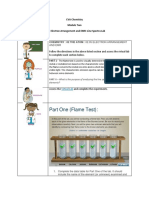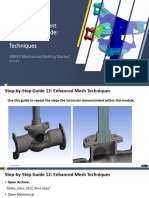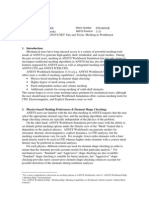0 ratings0% found this document useful (0 votes)
11 viewsMech GS 2019R2 EN WS12
Mech GS 2019R2 EN WS12
Uploaded by
Laxman DuggiralaThis document provides guidance on refining the mesh of a shaft bearing model using enhanced techniques in ANSYS. It instructs the user to open an existing model, review the initial mesh settings, generate the mesh, inspect for low quality elements, and then refine the mesh on specific parts like the bearings, housings and shaft using techniques like sphere of influence, coordinate systems and controlling element size. It estimates the memory requirements for solving the model and recommends regenerating contact detection after modifying the mesh.
Copyright:
© All Rights Reserved
Available Formats
Download as PDF, TXT or read online from Scribd
Mech GS 2019R2 EN WS12
Mech GS 2019R2 EN WS12
Uploaded by
Laxman Duggirala0 ratings0% found this document useful (0 votes)
11 views17 pagesThis document provides guidance on refining the mesh of a shaft bearing model using enhanced techniques in ANSYS. It instructs the user to open an existing model, review the initial mesh settings, generate the mesh, inspect for low quality elements, and then refine the mesh on specific parts like the bearings, housings and shaft using techniques like sphere of influence, coordinate systems and controlling element size. It estimates the memory requirements for solving the model and recommends regenerating contact detection after modifying the mesh.
Original Description:
Mech_GS_2019R2_EN_PR15
Original Title
Mech_GS_2019R2_EN_WS12
Copyright
© © All Rights Reserved
Available Formats
PDF, TXT or read online from Scribd
Share this document
Did you find this document useful?
Is this content inappropriate?
This document provides guidance on refining the mesh of a shaft bearing model using enhanced techniques in ANSYS. It instructs the user to open an existing model, review the initial mesh settings, generate the mesh, inspect for low quality elements, and then refine the mesh on specific parts like the bearings, housings and shaft using techniques like sphere of influence, coordinate systems and controlling element size. It estimates the memory requirements for solving the model and recommends regenerating contact detection after modifying the mesh.
Copyright:
© All Rights Reserved
Available Formats
Download as PDF, TXT or read online from Scribd
Download as pdf or txt
0 ratings0% found this document useful (0 votes)
11 views17 pagesMech GS 2019R2 EN WS12
Mech GS 2019R2 EN WS12
Uploaded by
Laxman DuggiralaThis document provides guidance on refining the mesh of a shaft bearing model using enhanced techniques in ANSYS. It instructs the user to open an existing model, review the initial mesh settings, generate the mesh, inspect for low quality elements, and then refine the mesh on specific parts like the bearings, housings and shaft using techniques like sphere of influence, coordinate systems and controlling element size. It estimates the memory requirements for solving the model and recommends regenerating contact detection after modifying the mesh.
Copyright:
© All Rights Reserved
Available Formats
Download as PDF, TXT or read online from Scribd
Download as pdf or txt
You are on page 1of 17
Module 12 Workshop:
Enhanced Mesh
Techniques
ANSYS Mechanical Getting Started
2019 R2
1 1 © 2019 ANSYS, Inc.
Workshop 12: Enhanced Mesh Techniques
Use this guide to work on the Journal Bearing model.
2 © 2019 ANSYS, Inc.
Workshop 12: Enhanced Mesh Techniques
• Open Archive: “Shaft_Bearings_WS12_Start.wbpz”
• Open Mechanical
3 © 2019 ANSYS, Inc.
Workshop 12: Enhanced Mesh Techniques
Review the existing Mesh settings:
• Defaults
− Physics Preference = Mechanical
− Element Size = 5.0 mm
• Sizing Objects
− Body Sizing 1 (Housings): Element Size = 3 mm
− Body Sizing 2 Bearings: Element Size = 1.5 mm
− Body Sizing 3 Grounds: Element Size = 6 mm
− Body Sizing 4 Rings: Element Size = 1 mm
− Body Sizing 5 Pulley: Element Size = 2 mm
4 © 2019 ANSYS, Inc.
Workshop 12: Enhanced Mesh Techniques
Generate the mesh on the model using the existing mesh settings, and note the
mesh connectivity between the Pulleys and the Shaft resulting from the Shared
Topology Shaft part:
5 © 2019 ANSYS, Inc.
Workshop 12: Enhanced Mesh Techniques
Confirm sharing of topology on the Shaft part by using the Explode tool; note the
Shaft body and Pulley bodies explode as 1 connected part:
• Select the Geometry Branch
• Explode the assembly using the
Explode slider in the Display tab
• You can also use the Edge Coloring tool to review geometry connections
6 © 2019 ANSYS, Inc.
Workshop 12: Enhanced Mesh Techniques
View bad quality elements:
• In details of Mesh: Quality—Mesh
Metric = Element Quality
• Click Controls in Mesh Metrics
window
• Set Y-Axis Max to 100
• Close the Y-Axis Option dialog to
display the Mesh Quality
histogram
7 © 2019 ANSYS, Inc.
Workshop 12: Enhanced Mesh Techniques
View the locations of the bad quality elements:
• Select individual bars on the graph to display only elements of that Element Quality
• Set Mesh Metric = None when finished
8 © 2019 ANSYS, Inc.
Workshop 12: Enhanced Mesh Techniques
We will refine or modify the mesh on the following bodies:
- Bearings
- Housings Based on the review of bad quality elements
- Pulley Based on the presence of wedges in the body
This part is our primary interest, so we’ll refine the mesh to
- Shaft
produce at least a few elements along a diameter and (thus) more
accurate results. This is particularly important because the shaft is
subjected to bending, and we’ll need several elements along a
diameter to portray bending accurately and to resolve the
variation of bending stress on a cross-section.
9 © 2019 ANSYS, Inc.
Workshop 12: Enhanced Mesh Techniques
Define the following settings:
- 2 Body Sizings on the Housings. Use Spheres of Influence. Select each housing body
shown below, right, and set Definition Type to Sphere of Influence. Use Radius and
Element Size shown below.
- The definition of coordinate systems at each refinement location is required for sphere
of influence controls; these are already defined as Coordinate Systems 3 and 4.
10 © 2019 ANSYS, Inc.
Workshop 12: Enhanced Mesh Techniques
Define the following settings:
- A Tetrahedrons, Patch Conforming method on the Pulleys
11 © 2019 ANSYS, Inc.
Workshop 12: Enhanced Mesh Techniques
Define the following settings:
- A Body Sizing of 4 mm on the Shaft
- Generate Mesh
12 © 2019 ANSYS, Inc.
Workshop 12: Enhanced Mesh Techniques
- Review the generated mesh
- Review the Mesh Quality Statistics and compare it to the previous generated mesh.
13 © 2019 ANSYS, Inc.
Workshop 12: Enhanced Mesh Techniques
Interrogate the mesh for purposes of determining node count and approximating
degrees of freedom and resulting memory requirements for the solution
• Mesh → Statistics → Nodes
• Node count ≅ 430,000
• 3 DOF per node ≅ 1,320,000 DOF
• 10-20 GB RAM / 1 M DOF
• This model will require a
minimum of 20 GB RAM to solve
in-core
14 © 2019 ANSYS, Inc.
Workshop 12: Enhanced Mesh Techniques
• The newly-generated mesh may alter contact detection, as contact detection
is based on the mesh, not on the solid geometry
• Therefore, it is a good practice to regenerate the Initial Contact Results after
mesh generation and before solution
• Are these results acceptable? Why or why
not?
• The contact region highlighted in yellow is
detected as open. This is not problematic
for the re-solution since it is a nonlinear
contact—its status can change during the
re-solution.
15 © 2019 ANSYS, Inc.
Workshop 12: Enhanced Mesh Techniques
Save Project for use later if desired.
16 © 2019 ANSYS, Inc.
Module 12 Workshop:
Enhanced Mesh
Techniques
END
1717 © 2019 ANSYS, Inc.
You might also like
- ANSYS Meshing CFD Case 1 - Generic CombustorDocument12 pagesANSYS Meshing CFD Case 1 - Generic CombustorDivyesh PatelNo ratings yet
- CFD TrainingDocument25 pagesCFD TrainingRui AuditoreNo ratings yet
- 02.05 Lab Electron Arrangement and EMR Line Spectra Virtual LabDocument5 pages02.05 Lab Electron Arrangement and EMR Line Spectra Virtual LabCaitlynNo ratings yet
- Mech GS 2019R2 EN PR12Document17 pagesMech GS 2019R2 EN PR12Laxman DuggiralaNo ratings yet
- Mech BSN 2019R3 EN M08Document36 pagesMech BSN 2019R3 EN M08cananbudak540No ratings yet
- Mech BSN 2019R3 EN WS08.1Document23 pagesMech BSN 2019R3 EN WS08.1cananbudak540No ratings yet
- Mech BSN 2019R3 EN WS01.2Document13 pagesMech BSN 2019R3 EN WS01.2cananbudak540No ratings yet
- Mesh-Intro 19R2 WS5.4 CFD Workshop Instructions ManifoldDocument16 pagesMesh-Intro 19R2 WS5.4 CFD Workshop Instructions ManifoldAbhishek yadavNo ratings yet
- Mesh-Intro 19R2 WS2.1 FEA Workshop Instructions ANSYS Meshing MethodsDocument26 pagesMesh-Intro 19R2 WS2.1 FEA Workshop Instructions ANSYS Meshing MethodsAbhishek yadavNo ratings yet
- Mesh-Intro 19R2 WS5.2 FEA Workshop Instructions Shell Pressure VesselDocument25 pagesMesh-Intro 19R2 WS5.2 FEA Workshop Instructions Shell Pressure VesselAbhishek yadavNo ratings yet
- 14.0 ANSYS Meshing: Duraivelan Dakshinamoorthy Sr. Technical Services Engineer ANSYS HoustonDocument55 pages14.0 ANSYS Meshing: Duraivelan Dakshinamoorthy Sr. Technical Services Engineer ANSYS HoustonL.a. MayorNo ratings yet
- Multizone Meshing For A Tank Geometry With PipingDocument17 pagesMultizone Meshing For A Tank Geometry With PipingMudassir FarooqNo ratings yet
- ACP Tutorial Ex2Document15 pagesACP Tutorial Ex2Reineiry GironNo ratings yet
- Ws14 Icemcfd Bentbar 51Document14 pagesWs14 Icemcfd Bentbar 51Ananto Yusuf WNo ratings yet
- 00 - Using Open Bridge Modeler and Lumenr RT Workshop PDFDocument50 pages00 - Using Open Bridge Modeler and Lumenr RT Workshop PDFSalvador Marcilla MuñozNo ratings yet
- Mech BSN 17.0 M07 Mesh Nonlinear AdaptivityDocument34 pagesMech BSN 17.0 M07 Mesh Nonlinear AdaptivityFrancisca Ignacia Jure BustamanteNo ratings yet
- Mesh-Intro 19R2 WS2.1 CFD Workshop Instructions ANSYS Meshing MethodsDocument28 pagesMesh-Intro 19R2 WS2.1 CFD Workshop Instructions ANSYS Meshing MethodsAbhishek yadavNo ratings yet
- Loading Structures Sections Tutorial Tutlssmeen24Document9 pagesLoading Structures Sections Tutorial Tutlssmeen24affanbhai.369No ratings yet
- Ask-The-experts ANSYS Advanced MeshingDocument47 pagesAsk-The-experts ANSYS Advanced MeshingShaheen S. RatnaniNo ratings yet
- ACP Tutorial Ex1Document30 pagesACP Tutorial Ex1mahendraNo ratings yet
- WB-Mech 120 WS 03.2Document12 pagesWB-Mech 120 WS 03.2jesycubanNo ratings yet
- AT06 - Airfoil-1Document44 pagesAT06 - Airfoil-1Angel BlancoNo ratings yet
- Mech Acous 2021R2 EN WS02.1 Car Acoustic ModesDocument13 pagesMech Acous 2021R2 EN WS02.1 Car Acoustic ModesluismcmcNo ratings yet
- ACP Tutorial Ex1Document34 pagesACP Tutorial Ex1mehrdadwborNo ratings yet
- Chapter 18. Modeling CavitationDocument30 pagesChapter 18. Modeling CavitationmiguelNo ratings yet
- Mech-Intro 14.0 WS04.1 MeshingDocument16 pagesMech-Intro 14.0 WS04.1 MeshingSilva Junior, E. J.No ratings yet
- Mech BSN 2019R3 EN WS06.2Document25 pagesMech BSN 2019R3 EN WS06.2cananbudak540No ratings yet
- ANSYS Meshing 12.0Document98 pagesANSYS Meshing 12.0Qiang Liu100% (2)
- ACP Intro 2020R1 WS03.1 RulesDocument16 pagesACP Intro 2020R1 WS03.1 RulesV CafNo ratings yet
- Multizone Meshing For A BlockDocument7 pagesMultizone Meshing For A BlockharshNo ratings yet
- ANSYS 11 - Crank - SimulationDocument38 pagesANSYS 11 - Crank - SimulationafaceanNo ratings yet
- AT08.3c - Surface Mesh PreparationDocument35 pagesAT08.3c - Surface Mesh PreparationAngel BlancoNo ratings yet
- Mechanical Intro 17.0 WS04.1 Mesh EvaluationDocument20 pagesMechanical Intro 17.0 WS04.1 Mesh EvaluationEmrahNo ratings yet
- Mesh-Intro 15.0 WS 07e ManifoldDocument25 pagesMesh-Intro 15.0 WS 07e ManifoldhaziqNo ratings yet
- Mech FracMech 2019R3 EN WS03.4 SubmodelDocument40 pagesMech FracMech 2019R3 EN WS03.4 SubmodelWilliam GarciaNo ratings yet
- Mesh ControlDocument60 pagesMesh ControlRanjeet SinghNo ratings yet
- Meshing in ANSYS WorkbenchDocument5 pagesMeshing in ANSYS Workbenchfr129834No ratings yet
- Mesh-Intro 19R2 WS5.1 CFD Workshop Instructions Mixing TankDocument33 pagesMesh-Intro 19R2 WS5.1 CFD Workshop Instructions Mixing TankAbhishek yadavNo ratings yet
- Mech BSN 2019R3 EN WS05.1Document29 pagesMech BSN 2019R3 EN WS05.1cananbudak540No ratings yet
- Mesh-Intro 19R2 WS5.1 Explicit Workshop Instructions ProjectileDocument26 pagesMesh-Intro 19R2 WS5.1 Explicit Workshop Instructions ProjectileAbhishek yadavNo ratings yet
- 4 Shrink Wrap - 13Document2 pages4 Shrink Wrap - 13Varun ChaitanyaNo ratings yet
- Mesh-Intro 16.0 WS 07e ManifoldDocument20 pagesMesh-Intro 16.0 WS 07e ManifoldAnand NairNo ratings yet
- Practice Workbook: Modeling Structural MembersDocument44 pagesPractice Workbook: Modeling Structural MembersclarkgaguiNo ratings yet
- Mesh-Intro 16.0 WS 07a Mixing Tank PDFDocument37 pagesMesh-Intro 16.0 WS 07a Mixing Tank PDFmanjeet_virkNo ratings yet
- Mesh-Intro 14.5 L07 Assembly MeshingDocument32 pagesMesh-Intro 14.5 L07 Assembly Meshinganmol6237No ratings yet
- ACP (ANSYS Composite Prep/Post) : Jim KosloskiDocument23 pagesACP (ANSYS Composite Prep/Post) : Jim KosloskiResul SahinNo ratings yet
- AT07.1a - Elbow AdaptionDocument22 pagesAT07.1a - Elbow AdaptionAngel BlancoNo ratings yet
- Ansys Mechanical TrainingDocument54 pagesAnsys Mechanical TrainingAbhijeet Gandage100% (3)
- Mesh-Intro 17.0 WS1.1 CFD ANSYS WB Meshing BasicsDocument21 pagesMesh-Intro 17.0 WS1.1 CFD ANSYS WB Meshing Basicsmarcosandia1974No ratings yet
- Introduction DXDocument38 pagesIntroduction DXEric CamposNo ratings yet
- Ws15 Icemcfd Hvac 51Document18 pagesWs15 Icemcfd Hvac 51Jeff Anderson CollinsNo ratings yet
- Mech FracMech 2019R3 en WS03.3 ArbitraryCrackDocument27 pagesMech FracMech 2019R3 en WS03.3 ArbitraryCrackWilliam GarciaNo ratings yet
- AM-Intro 13.0 L03 Global Mesh SettingsDocument37 pagesAM-Intro 13.0 L03 Global Mesh SettingsCarlos AméricoNo ratings yet
- Mech Intro 18.0 WS03.2 Workshop Instructions Beam ConnectionsDocument19 pagesMech Intro 18.0 WS03.2 Workshop Instructions Beam ConnectionsLeandro Lima RamaldesNo ratings yet
- 05 Axial Fan Using ATM Optimized TopologyDocument10 pages05 Axial Fan Using ATM Optimized TopologyrewmarineNo ratings yet
- Module 4 - Fluid Flow and Heat Transfer Over A Circular CylinderDocument36 pagesModule 4 - Fluid Flow and Heat Transfer Over A Circular CylinderAkshay DolasNo ratings yet
- Mechanical Intro 17.0 M05 Mesh ControlDocument59 pagesMechanical Intro 17.0 M05 Mesh ControlSamedŠkuljNo ratings yet
- AutoCAD Electrical 2020 for Electrical Control Designers, 11th EditionFrom EverandAutoCAD Electrical 2020 for Electrical Control Designers, 11th EditionNo ratings yet
- Standards Spec Brochure ME WEBDocument44 pagesStandards Spec Brochure ME WEBLaxman Duggirala100% (1)
- TeknosDocument76 pagesTeknosMartin LafonNo ratings yet
- Hot Dip Galvanizing and Corrosion CategoriesDocument2 pagesHot Dip Galvanizing and Corrosion CategoriesLaxman DuggiralaNo ratings yet
- HV-CONNEX Pluggable Connection System-Size 5SDocument15 pagesHV-CONNEX Pluggable Connection System-Size 5SLaxman DuggiralaNo ratings yet
- Guide To Netaji MysteryDocument6 pagesGuide To Netaji MysteryLaxman DuggiralaNo ratings yet
- Dehonit ElektroDocument6 pagesDehonit ElektroLaxman DuggiralaNo ratings yet
- SDLP - Body Parts of Animals That Live in Water - 4Document4 pagesSDLP - Body Parts of Animals That Live in Water - 4Edmund IgnacioNo ratings yet
- A Mini-Introduction To Information Theory: Edward WittenDocument39 pagesA Mini-Introduction To Information Theory: Edward WittendasdNo ratings yet
- Additional Manual Siemen S7-200 PDFDocument39 pagesAdditional Manual Siemen S7-200 PDFJoko Suwito UtomoNo ratings yet
- 2130903Document18 pages2130903mitaliNo ratings yet
- Ship Breaking and Recycling Industry in Bangladesh and PakistanDocument105 pagesShip Breaking and Recycling Industry in Bangladesh and PakistanhossainctgNo ratings yet
- Socrates 469-399 BC: "Withdraw Into Yourself Truth Dwells in The Inner Man."Document7 pagesSocrates 469-399 BC: "Withdraw Into Yourself Truth Dwells in The Inner Man."Ma. Luisa RenidoNo ratings yet
- X - Maths - DPT PaperDocument2 pagesX - Maths - DPT Paperlatharamreddygari2112No ratings yet
- Design of Commercial Building by Staad Pro 115 PDFDocument19 pagesDesign of Commercial Building by Staad Pro 115 PDF20-C-114 Sūshmã HîñdhūNo ratings yet
- The Effect of Reservations On CasteDocument21 pagesThe Effect of Reservations On CasteShubhra RaiNo ratings yet
- Speaking Test Content - C.41 - Cấp 2Document6 pagesSpeaking Test Content - C.41 - Cấp 2Ngọc BíchNo ratings yet
- Notation in Probability and Statistics - WikipediaDocument13 pagesNotation in Probability and Statistics - WikipediaHussain BirmaniNo ratings yet
- Zuckerberg Began Using Computers and Writing Software As A Child in Middle SchoolDocument2 pagesZuckerberg Began Using Computers and Writing Software As A Child in Middle SchoolWon Young SeoNo ratings yet
- Programming Laboratory Lab - ManualDocument56 pagesProgramming Laboratory Lab - ManualAmit SangaleNo ratings yet
- Inkandvolt Yearly Planning Week1Document3 pagesInkandvolt Yearly Planning Week1ashleyNo ratings yet
- Servtime - Computation of Service TimesDocument11 pagesServtime - Computation of Service Timescp3y2000-scribdNo ratings yet
- History Mission 35Document69 pagesHistory Mission 35vi ju100% (1)
- Central New York Regional Planning & Development BoardDocument25 pagesCentral New York Regional Planning & Development BoardChris CarrickNo ratings yet
- CH 6 Tutorial 2016Document5 pagesCH 6 Tutorial 2016Steven KuaNo ratings yet
- 8TH Tamil NotesDocument13 pages8TH Tamil NotesGanesh Eshwar67% (3)
- Egoless ProgrammingDocument2 pagesEgoless ProgrammingjabbanNo ratings yet
- Answer Keys AndreDocument4 pagesAnswer Keys AndreayususantinaNo ratings yet
- Power and DominationDocument1 pagePower and DominationKesto LoriakNo ratings yet
- Giao An 11 He Doi MoiDocument71 pagesGiao An 11 He Doi MoiQuynh NguyenNo ratings yet
- CAPS Performance Appraisal Webinar - July 2016Document59 pagesCAPS Performance Appraisal Webinar - July 2016cjsloanNo ratings yet
- Student Book - Unit 6-Book 2Document10 pagesStudent Book - Unit 6-Book 2Ruiz Guerrero Julio César de JesúsNo ratings yet
- The Last Cultural MileDocument216 pagesThe Last Cultural MileAtreya DeyNo ratings yet
- How To Write A JournalDocument28 pagesHow To Write A JournalSadudee ChamnankijNo ratings yet
- Eshiemogie Ojo Evans 2011Document118 pagesEshiemogie Ojo Evans 2011Federico ZurbriggenNo ratings yet
- Predicting Transformer Temperature Rise and Loss of Life in The Presence of Harmonic Load CurrentsDocument9 pagesPredicting Transformer Temperature Rise and Loss of Life in The Presence of Harmonic Load Currentsaisya mutia syafiiNo ratings yet































































































